Essential Management of Pediatric Brain Tumors
Abstract
1. Introduction
2. Clinical Assessment/Symptoms
3. Diagnostics
4. Clinical Approach and Therapy
4.1. The Role of Neurosurgery
4.2. The Role of Radio-Oncology
4.3. The Role of the Neuro-Oncology
4.3.1. Chemotherapy
4.3.2. Immunotherapy
4.3.3. Anti-Angiogenic Therapy
4.3.4. Tumor-Treating Fields
4.4. The Role of Neuropathology and Molecular Neuropathology
5. Molecular Advances and Their Effects on Clinical Management
5.1. Integrated Diagnosis
5.2. Medulloblastoma
5.3. Glioma
5.3.1. Low-Grade Glioma
5.3.2. High-Grade Glioma and Midline Glioma
5.4. Ependymoma
6. Future Perspectives
Author Contributions
Funding
Institutional Review Board Statement
Informed Consent Statement
Data Availability Statement
Conflicts of Interest
References
- Udaka, Y.T.; Packer, R.J. Pediatric Brain Tumors. Neurol. Clin. 2018, 36, 533–556. [Google Scholar] [CrossRef] [PubMed]
- Pollack, I.F.; Agnihotri, S.; Broniscer, A. Childhood brain tumors: Current management, biological insights, and future directions. J. Neurosurg. Pediatr. 2019, 23, 261–273. [Google Scholar] [CrossRef] [PubMed]
- Melcher, V.; Kerl, K. The Growing Relevance of Immunoregulation in Pediatric Brain Tumors. Cancers 2021, 13, 5601. [Google Scholar] [CrossRef]
- WHO Classification of Tumours Editorial Board. WHO Classification of Tumours Editorial Board. Central Nervous System Tumours, 5th ed.; International Agency for Research on Cancer: Lyon, France, 2021. [Google Scholar]
- Fangusaro, J.; Bandopadhayay, P. Advances in the classification and treatment of pediatric brain tumors. Curr. Opin. Pediatr. 2021, 33, 26–32. [Google Scholar] [CrossRef] [PubMed]
- Louis, D.N.; Perry, A.; Reifenberger, G.; von Deimling, A.; Figarella-Branger, D.; Cavenee, W.K.; Ohgaki, H.; Wiestler, O.D.; Kleihues, P.; Ellison, D.W. The 2016 World Health Organization Classification of Tumors of the Central Nervous System: A summary. Acta Neuropathol. 2016, 131, 803–820. [Google Scholar] [CrossRef]
- Louis, D.N.; Perry, A.; Wesseling, P.; Brat, D.J.; Cree, I.A.; Figarella-Branger, D.; Hawkins, C.; Ng, H.K.; Pfister, S.M.; Reifenberger, G.; et al. The 2021 WHO Classification of Tumors of the Central Nervous System: A summary. Neuro Oncol. 2021, 23, 1231–1251. [Google Scholar] [CrossRef]
- Miller, K.D.; Ostrom, Q.T.; Kruchko, C.; Patil, N.; Tihan, T.; Cioffi, G.; Fuchs, H.E.; Waite, K.A.; Jemal, A.; Siegel, R.L.; et al. Brain and other central nervous system tumor statistics, 2021. CA Cancer J. Clin. 2021, 71, 381–406. [Google Scholar] [CrossRef]
- Li, Q.; Dai, Z.; Cao, Y.; Wang, L. Comparing children and adults with medulloblastoma: A SEER based analysis. Oncotarget 2018, 9, 30189–30198. [Google Scholar] [CrossRef]
- A Cure Can’t Wait. Available online: https://www.thebraintumourcharity.org/ (accessed on 13 February 2022).
- National Brain Tumor Society WALKS, RIDES, and RACES. Available online: https://events.braintumor.org/ (accessed on 13 February 2022).
- Chu, T.P.; Shah, A.; Walker, D.; Coleman, M.P. Pattern of symptoms and signs of primary intracranial tumours in children and young adults: A record linkage study. Arch. Dis. Child. 2015, 100, 1115–1122. [Google Scholar] [CrossRef] [PubMed]
- Reulecke, B.C.; Erker, C.G.; Fiedler, B.J.; Niederstadt, T.U.; Kurlemann, G. Brain tumors in children: Initial symptoms and their influence on the time span between symptom onset and diagnosis. J. Child Neurol. 2008, 23, 178–183. [Google Scholar] [CrossRef] [PubMed]
- Rao, P. Role of MRI in paediatric neurooncology. Eur. J. Radiol. 2008, 68, 259–270. [Google Scholar] [CrossRef] [PubMed]
- Han, H.; Han, C.; Wu, X.; Zhong, S.; Zhuang, X.; Tan, G.; Wu, H. Preoperative grading of supratentorial nonenhancing gliomas by high b-value diffusion-weighted 3 T magnetic resonance imaging. J. Neurooncol. 2017, 133, 147–154. [Google Scholar] [CrossRef] [PubMed]
- Caravan, I.; Ciortea, C.A.; Contis, A.; Lebovici, A. Diagnostic value of apparent diffusion coefficient in differentiating between high-grade gliomas and brain metastases. Acta Radiol. 2018, 59, 599–605. [Google Scholar] [CrossRef] [PubMed]
- Huang, R.Y.; Lin, A. Whole-Brain MR Spectroscopy Imaging of Brain Tumor Metabolites. Radiology 2020, 294, 598–599. [Google Scholar] [CrossRef] [PubMed]
- Millard, N.E.; De Braganca, K.C. Medulloblastoma. J. Child Neurol. 2016, 31, 1341–1353. [Google Scholar] [CrossRef]
- Roth, J.; Fischer, N.; Limbrick, D.D.; CreveCoeur, T.; Ben-Sira, L.; Constantini, S. The role of screening spinal MRI in children with solitary posterior fossa low-grade glial tumors. J. Neurosurg. Pediatr. 2019, 25, 106–110. [Google Scholar] [CrossRef] [PubMed]
- Keene, D.; Johnston, D.; Strother, D.; Fryer, C.; Carret, A.S.; Crooks, B.; Eisenstat, D.; Moghrabi, A.; Wilson, B.; Brossard, J.; et al. Epidemiological survey of central nervous system germ cell tumors in Canadian children. J. Neurooncol. 2007, 82, 289–295. [Google Scholar] [CrossRef]
- Singhi, S.C.; Tiwari, L. Management of intracranial hypertension. Indian J. Pediatr. 2009, 76, 519–529. [Google Scholar] [CrossRef]
- McClain, C.D.; Soriano, S.G. Anesthesia for intracranial surgery in infants and children. Curr. Opin. Anaesthesiol. 2014, 27, 465–469. [Google Scholar] [CrossRef] [PubMed][Green Version]
- Shiminski-Maher, T. Brain tumors in childhood: Implications for nursing practice. J. Pediatr. Health Care 1990, 4, 122–130. [Google Scholar] [CrossRef]
- Sala, F.; Coppola, A.; Tramontano, V.; Babini, M.; Pinna, G. Intraoperative neurophysiological monitoring for the resection of brain tumors in pediatric patients. J. Neurosurg. Sci. 2015, 59, 373–382. [Google Scholar] [PubMed]
- Fuller, C. A little piece of mind: Best practices for brain tumor intraoperative consultation. Mod. Pathol. 2019, 32, 44–57. [Google Scholar] [CrossRef]
- Rudà, R.; Reifenberger, G.; Frappaz, D.; Pfister, S.M.; Laprie, A.; Santarius, T.; Roth, P.; Tonn, J.C.; Soffietti, R.; Weller, M.; et al. EANO guidelines for the diagnosis and treatment of ependymal tumors. Neuro Oncol. 2018, 20, 445–456. [Google Scholar] [CrossRef] [PubMed]
- Finlay, J.L.; Wisoff, J.H. The impact of extent of resection in the management of malignant gliomas of childhood. Child’s Nerv. Syst. 1999, 15, 786–788. [Google Scholar] [CrossRef] [PubMed]
- Merchant, T.E.; Li, C.; Xiong, X.; Kun, L.E.; Boop, F.A.; Sanford, R.A. Conformal radiotherapy after surgery for paediatric ependymoma: A prospective study. Lancet Oncol. 2009, 10, 258–266. [Google Scholar] [CrossRef]
- White, G.E.; Caterini, J.E.; McCann, V.; Rendall, K.; Nathan, P.C.; Rhind, S.G.; Jones, H.; Wells, G.D. The Psychoneuroimmunology of Stress Regulation in Pediatric Cancer Patients. Cancers 2021, 13, 4684. [Google Scholar] [CrossRef]
- Silva, A.H.D.; Aquilina, K. Surgical approaches in pediatric neuro-oncology. Cancer Metastasis Rev. 2019, 38, 723–747. [Google Scholar] [CrossRef]
- Coppola, A.; Tramontano, V.; Basaldella, F.; Arcaro, C.; Squintani, G.; Sala, F. Intra-operative neurophysiological mapping and monitoring during brain tumour surgery in children: An update. Child’s Nerv. Syst. 2016, 32, 1849–1859. [Google Scholar] [CrossRef]
- Souweidane, M.M. The evolving role of surgery in the management of pediatric brain tumors. J. Child Neurol. 2009, 24, 1366–1374. [Google Scholar] [CrossRef]
- Smith, H.; Taplin, A.; Syed, S.; Adamo, M.A. Correlation between intraoperative ultrasound and postoperative MRI in pediatric tumor surgery. J. Neurosurg. Pediatr. 2016, 18, 578–584. [Google Scholar] [CrossRef]
- Jödicke, A.; Springer, T.; Böker, D.K. Real-time integration of ultrasound into neuronavigation: Technical accuracy using a light-emitting-diode-based navigation system. Acta Neurochir. 2004, 146, 1211–1220. [Google Scholar] [CrossRef] [PubMed]
- Giordano, M.; Samii, A.; Lawson McLean, A.C.; Bertalanffy, H.; Fahlbusch, R.; Samii, M.; Di Rocco, C. Intraoperative magnetic resonance imaging in pediatric neurosurgery: Safety and utility. J. Neurosurg. Pediatr. 2017, 19, 77–84. [Google Scholar] [CrossRef] [PubMed]
- Roder, C.; Breitkopf, M.; Bisdas, S.; Freitas Rda, S.; Dimostheni, A.; Ebinger, M.; Wolff, M.; Tatagiba, M.; Schuhmann, M.U. Beneficial impact of high-field intraoperative magnetic resonance imaging on the efficacy of pediatric low-grade glioma surgery. Neurosurg. Focus 2016, 40, E13. [Google Scholar] [CrossRef] [PubMed]
- Moussazadeh, N.; Prabhu, V.; Bander, E.D.; Cusic, R.C.; Tsiouris, A.J.; Anand, V.K.; Schwartz, T.H. Endoscopic endonasal versus open transcranial resection of craniopharyngiomas: A case-matched single-institution analysis. Neurosurg. Focus 2016, 41, E7. [Google Scholar] [CrossRef]
- Neuloh, G.; Pechstein, U.; Cedzich, C.; Schramm, J. Motor evoked potential monitoring with supratentorial surgery. Neurosurgery 2007, 61, 337–346, discussion 338–346. [Google Scholar] [CrossRef] [PubMed]
- Schucht, P.; Seidel, K.; Jilch, A.; Beck, J.; Raabe, A. A review of monopolar motor mapping and a comprehensive guide to continuous dynamic motor mapping for resection of motor eloquent brain tumors. Neurochirurgie 2017, 63, 175–180. [Google Scholar] [CrossRef] [PubMed]
- Seidel, K.; Beck, J.; Stieglitz, L.; Schucht, P.; Raabe, A. Low-threshold monopolar motor mapping for resection of primary motor cortex tumors. Neurosurgery 2012, 71, 104–114, discussion 105–114. [Google Scholar] [CrossRef]
- Roujeau, T.; Machado, G.; Garnett, M.R.; Miquel, C.; Puget, S.; Geoerger, B.; Grill, J.; Boddaert, N.; Di Rocco, F.; Zerah, M.; et al. Stereotactic biopsy of diffuse pontine lesions in children. J. Neurosurg. 2007, 107, 1–4. [Google Scholar] [CrossRef]
- Iwama, J.; Ogiwara, H.; Kiyotani, C.; Terashima, K.; Matsuoka, K.; Iwafuchi, H.; Morota, N. Neoadjuvant chemotherapy for brain tumors in infants and young children. J. Neurosurg. Pediatr. 2015, 15, 488–492. [Google Scholar] [CrossRef]
- Ludmir, E.B.; Grosshans, D.R.; Woodhouse, K.D. Radiotherapy Advances in Pediatric Neuro-Oncology. Bioengineering 2018, 5, 97. [Google Scholar] [CrossRef]
- Wang, T.; Manohar, N.; Lei, Y.; Dhabaan, A.; Shu, H.K.; Liu, T.; Curran, W.J.; Yang, X. MRI-based treatment planning for brain stereotactic radiosurgery: Dosimetric validation of a learning-based pseudo-CT generation method. Med. Dosim. 2019, 44, 199–204. [Google Scholar] [CrossRef]
- Mochizuki, A.Y.; Frost, I.M.; Mastrodimos, M.B.; Plant, A.S.; Wang, A.C.; Moore, T.B.; Prins, R.M.; Weiss, P.S.; Jonas, S.J. Precision Medicine in Pediatric Neurooncology: A Review. ACS Chem. Neurosci. 2018, 9, 11–28. [Google Scholar] [CrossRef] [PubMed]
- The Royal College of Radiologists, Clinical Oncology. Radiotherapy Dose Fractionation, 3rd ed.; The Royal College of Radiologists: London, UK, 2019; pp. 70–74. [Google Scholar]
- Park, J.; Yea, J.W.; Park, J.W. Hypofractionated radiotherapy versus conventional radiotherapy for diffuse intrinsic pontine glioma: A systematic review and meta-analysis. Medicine 2020, 99, e22721. [Google Scholar] [CrossRef] [PubMed]
- Levin, W.P.; Kooy, H.; Loeffler, J.S.; DeLaney, T.F. Proton beam therapy. Br. J. Cancer 2005, 93, 849–854. [Google Scholar] [CrossRef]
- Cacciotti, C.; Fleming, A.; Ramaswamy, V. Advances in the molecular classification of pediatric brain tumors: A guide to the galaxy. J. Pathol. 2020, 251, 249–261. [Google Scholar] [CrossRef] [PubMed]
- Wefers, A.K.; Stichel, D.; Schrimpf, D.; Coras, R.; Pages, M.; Tauziède-Espariat, A.; Varlet, P.; Schwarz, D.; Söylemezoglu, F.; Pohl, U.; et al. Isomorphic diffuse glioma is a morphologically and molecularly distinct tumour entity with recurrent gene fusions of MYBL1 or MYB and a benign disease course. Acta Neuropathol. 2020, 139, 193–209. [Google Scholar] [CrossRef] [PubMed]
- Argersinger, D.P.; Rivas, S.R.; Shah, A.H.; Jackson, S.; Heiss, J.D. New Developments in the Pathogenesis, Therapeutic Targeting, and Treatment of H3K27M-Mutant Diffuse Midline Glioma. Cancers 2021, 13, 5280. [Google Scholar] [CrossRef] [PubMed]
- Walker, D.A.; Liu, J.; Kieran, M.; Jabado, N.; Picton, S.; Packer, R.; St Rose, C. A multi-disciplinary consensus statement concerning surgical approaches to low-grade, high-grade astrocytomas and diffuse intrinsic pontine gliomas in childhood (CPN Paris 2011) using the Delphi method. Neuro Oncol. 2013, 15, 462–468. [Google Scholar] [CrossRef] [PubMed]
- Hu, W.; Duan, H.; Zhong, S.; Zeng, J.; Mou, Y. High frequency of PDGFRA and MUC family gene mutations in diffuse hemispheric glioma, H3 G34-mutant: A glimmer of hope? J. Transl. Med. 2022, 20, 64. [Google Scholar] [CrossRef] [PubMed]
- Mançano, B.M.; Dos Reis, M.B.; Moreno, D.A.; de Paula, F.E.; de Almeida Junior, C.R.; Cavalcante, C.E.B.; Zanon, M.F.; Santana, I.V.V.; Matsushita, M.M.; Reis, R.M. A Unique Case Report of Infant-Type Hemispheric Glioma (Gliosarcoma Subtype) with TPR-NTRK1 Fusion Treated with Larotrectinib. Pathobiology 2022, 1–8. [Google Scholar] [CrossRef]
- Bender, K.; Perez, E.; Chirica, M.; Onken, J.; Kahn, J.; Brenner, W.; Ehret, F.; Euskirchen, P.; Koch, A.; Capper, D.; et al. High-grade astrocytoma with piloid features (HGAP): The Charité experience with a new central nervous system tumor entity. J. Neurooncol. 2021, 153, 109–120. [Google Scholar] [CrossRef] [PubMed]
- Shaikh, N.; Brahmbhatt, N.; Kruser, T.J.; Kam, K.-L.; Appin, C.; Wadhwani, N.R.; Chandler, J.P.; Kumthekar, P.; Lukas, R.V. Pleomorphic xanthoastrocytoma: A brief review. CNS Oncol. 2019, 8, CNS39. [Google Scholar] [CrossRef] [PubMed]
- Ebrahimi-Fakhari, D.; Franz, D.N. Pharmacological treatment strategies for subependymal giant cell astrocytoma (SEGA). Expert Opin. Pharmacother. 2020, 21, 1329–1336. [Google Scholar] [CrossRef]
- Nguyen, H.S.; Doan, N.B.; Gelsomino, M.; Shabani, S.; Awad, A.J.; Best, B.; Kaushal, M.; Mortazavi, M.M. Subependymal Giant Cell Astrocytoma: A Surveillance, Epidemiology, and End Results Program-Based Analysis from 2004 to 2013. World Neurosurg. 2018, 118, e263–e268. [Google Scholar] [CrossRef] [PubMed]
- Reddy, A.T.; Strother, D.R.; Judkins, A.R.; Burger, P.C.; Pollack, I.F.; Krailo, M.D.; Buxton, A.B.; Williams-Hughes, C.; Fouladi, M.; Mahajan, A.; et al. Efficacy of High-Dose Chemotherapy and Three-Dimensional Conformal Radiation for Atypical Teratoid/Rhabdoid Tumor: A Report from the Children’s Oncology Group Trial ACNS0333. J. Clin. Oncol. 2020, 38, 1175–1185. [Google Scholar] [CrossRef] [PubMed]
- Kumar, N.; Madan, R.; Gupta, K.; Chatterjee, D.; Uppal, D.K.; Goyal, S.; Ballari, N.; Khosla, D.; Sahoo, S.K.; Ahuja, C.K. Embryonal tumors with multilayered rosettes: A tertiary care centre experience. Clin. Neurol. Neurosurg. 2021, 202, 106508. [Google Scholar] [CrossRef] [PubMed]
- Pearl, M.S.; Gupta, N.; Hetts, S.W. Interventional neuro-oncology. Handb. Clin. Neurol. 2021, 176, 361–378. [Google Scholar] [CrossRef] [PubMed]
- Triarico, S.; Maurizi, P.; Mastrangelo, S.; Attinà, G.; Capozza, M.A.; Ruggiero, A. Improving the Brain Delivery of Chemotherapeutic Drugs in Childhood Brain Tumors. Cancers 2019, 11, 824. [Google Scholar] [CrossRef]
- Mueller, S.; Chang, S. Pediatric brain tumors: Current treatment strategies and future therapeutic approaches. Neurotherapeutics 2009, 6, 570–586. [Google Scholar] [CrossRef] [PubMed]
- Wang, S.S.; Bandopadhayay, P.; Jenkins, M.R. Towards Immunotherapy for Pediatric Brain Tumors. Trends Immunol. 2019, 40, 748–761. [Google Scholar] [CrossRef]
- Hwang, E.I.; Sayour, E.J.; Flores, C.T.; Grant, G.; Wechsler-Reya, R.; Hoang-Minh, L.B.; Kieran, M.W.; Salcido, J.; Prins, R.M.; Figg, J.W.; et al. The current landscape of immunotherapy for pediatric brain tumors. Nat. Cancer 2022, 3, 11–24. [Google Scholar] [CrossRef] [PubMed]
- Sie, M.; den Dunnen, W.F.; Hoving, E.W.; de Bont, E.S. Anti-angiogenic therapy in pediatric brain tumors: An effective strategy? Crit. Rev. Oncol. Hematol. 2014, 89, 418–432. [Google Scholar] [CrossRef]
- Crotty, E.E.; Leary, S.E.S.; Geyer, J.R.; Olson, J.M.; Millard, N.E.; Sato, A.A.; Ermoian, R.P.; Cole, B.L.; Lockwood, C.M.; Paulson, V.A.; et al. Children with DIPG and high-grade glioma treated with temozolomide, irinotecan, and bevacizumab: The Seattle Children’s Hospital experience. J. Neurooncol. 2020, 148, 607–617. [Google Scholar] [CrossRef] [PubMed]
- Stupp, R.; Taillibert, S.; Kanner, A.; Read, W.; Steinberg, D.; Lhermitte, B.; Toms, S.; Idbaih, A.; Ahluwalia, M.S.; Fink, K.; et al. Effect of Tumor-Treating Fields Plus Maintenance Temozolomide vs. Maintenance Temozolomide Alone on Survival in Patients with Glioblastoma: A Randomized Clinical Trial. JAMA 2017, 318, 2306–2316. [Google Scholar] [CrossRef] [PubMed]
- Makimoto, A.; Nishikawa, R.; Terashima, K.; Kurihara, J.; Fujisaki, H.; Ihara, S.; Morikawa, Y.; Yuza, Y. Tumor-Treating Fields Therapy for Pediatric Brain Tumors. Neurol. Int. 2021, 13, 151–165. [Google Scholar] [CrossRef] [PubMed]
- Piekarski, F.; Neef, V.; Meybohm, P.; Rolle, U.; Schneider, W.; Zacharowski, K.; Schmitt, E. Independent Risk Factors for RBC Transfusion in Children Undergoing Surgery. Analysis of 14,248 Cases at a German University Hospital. Children 2021, 8, 634. [Google Scholar] [CrossRef]
- Kumar, R.; Liu, A.P.Y.; Orr, B.A.; Northcott, P.A.; Robinson, G.W. Advances in the classification of pediatric brain tumors through DNA methylation profiling: From research tool to frontline diagnostic. Cancer 2018, 124, 4168–4180. [Google Scholar] [CrossRef]
- Anamika, K.; Verma, S.P.; Jere, A.; Desai, A. Transcriptomic Profiling Using Next Generation Sequencing—Advances, Advantages, and Challenges. In Next Generation Sequencing-Advances, Applications and Challenges; BoD–Books on Demand: Norderstedt, Germany, 2016. [Google Scholar]
- Northcott, P.A.; Buchhalter, I.; Morrissy, A.S.; Hovestadt, V.; Weischenfeldt, J.; Ehrenberger, T.; Gröbner, S.; Segura-Wang, M.; Zichner, T.; Rudneva, V.A.; et al. The whole-genome landscape of medulloblastoma subtypes. Nature 2017, 547, 311–317. [Google Scholar] [CrossRef] [PubMed]
- von Hoff, K.; Haberler, C.; Schmitt-Hoffner, F.; Schepke, E.; de Rojas, T.; Jacobs, S.; Zapotocky, M.; Sumerauer, D.; Perek-Polnik, M.; Dufour, C.; et al. Therapeutic implications of improved molecular diagnostics for rare CNS embryonal tumor entities: Results of an international, retrospective study. Neuro Oncol. 2021, 23, 1597–1611. [Google Scholar] [CrossRef] [PubMed]
- Juraschka, K.; Taylor, M.D. Medulloblastoma in the age of molecular subgroups: A review. J. Neurosurg. Pediatr. 2019, 24, 353–363. [Google Scholar] [CrossRef]
- Taylor, M.D.; Northcott, P.A.; Korshunov, A.; Remke, M.; Cho, Y.J.; Clifford, S.C.; Eberhart, C.G.; Parsons, D.W.; Rutkowski, S.; Gajjar, A.; et al. Molecular subgroups of medulloblastoma: The current consensus. Acta Neuropathol. 2012, 123, 465–472. [Google Scholar] [CrossRef] [PubMed]
- Ramaswamy, V.; Remke, M.; Bouffet, E.; Bailey, S.; Clifford, S.C.; Doz, F.; Kool, M.; Dufour, C.; Vassal, G.; Milde, T.; et al. Risk stratification of childhood medulloblastoma in the molecular era: The current consensus. Acta Neuropathol. 2016, 131, 821–831. [Google Scholar] [CrossRef] [PubMed]
- Caimano, M.; Lospinoso Severini, L.; Loricchio, E.; Infante, P.; Di Marcotullio, L. Drug Delivery Systems for Hedgehog Inhibitors in the Treatment of SHH-Medulloblastoma. Front. Chem. 2021, 9, 688108. [Google Scholar] [CrossRef] [PubMed]
- Maier, H.; Dalianis, T.; Kostopoulou, O.N. New Approaches in Targeted Therapy for Medulloblastoma in Children. Anticancer Res. 2021, 41, 1715–1726. [Google Scholar] [CrossRef]
- Sievert, A.J.; Fisher, M.J. Pediatric low-grade gliomas. J. Child Neurol. 2009, 24, 1397–1408. [Google Scholar] [CrossRef] [PubMed]
- Soleman, J.; Kozyrev, D.A.; Ben-Sira, L.; Constantini, S.; Roth, J. Management of incidental brain tumors in children: A systematic review. Child’s Nerv. Syst. 2020, 36, 1607–1619. [Google Scholar] [CrossRef] [PubMed]
- Ryall, S.; Tabori, U.; Hawkins, C. Pediatric low-grade glioma in the era of molecular diagnostics. Acta Neuropathol. Commun. 2020, 8, 30. [Google Scholar] [CrossRef] [PubMed]
- Nix, J.S.; Blakeley, J.; Rodriguez, F.J. An update on the central nervous system manifestations of neurofibromatosis type 1. Acta Neuropathol. 2020, 139, 625–641. [Google Scholar] [CrossRef]
- Packer, R.J.; Vezina, G. New treatment modalities in NF-related neuroglial tumors. Child’s Nerv. Syst. 2020, 36, 2377–2384. [Google Scholar] [CrossRef] [PubMed]
- Green, A.L.; Mulcahy Levy, J.M.; Vibhakar, R.; Hemenway, M.; Madden, J.; Foreman, N.; Dorris, K. Tumor treating fields in pediatric high-grade glioma. Child’s Nerv. Syst. 2017, 33, 1043–1045. [Google Scholar] [CrossRef] [PubMed]
- Clarke, M.; Mackay, A.; Ismer, B.; Pickles, J.C.; Tatevossian, R.G.; Newman, S.; Bale, T.A.; Stoler, I.; Izquierdo, E.; Temelso, S.; et al. Infant High-Grade Gliomas Comprise Multiple Subgroups Characterized by Novel Targetable Gene Fusions and Favorable Outcomes. Cancer Discov. 2020, 10, 942–963. [Google Scholar] [CrossRef] [PubMed]
- Findlay, I.J.; De Iuliis, G.N.; Duchatel, R.J.; Jackson, E.R.; Vitanza, N.A.; Cain, J.E.; Waszak, S.M.; Dun, M.D. Pharmaco-proteogenomic profiling of pediatric diffuse midline glioma to inform future treatment strategies. Oncogene 2022, 41, 461–475. [Google Scholar] [CrossRef] [PubMed]
- Vitanza, N.A.; Biery, M.C.; Myers, C.; Ferguson, E.; Zheng, Y.; Girard, E.J.; Przystal, J.M.; Park, G.; Noll, A.; Pakiam, F.; et al. Optimal therapeutic targeting by HDAC inhibition in biopsy-derived treatment-naïve diffuse midline glioma models. Neuro Oncol. 2021, 23, 376–386. [Google Scholar] [CrossRef] [PubMed]
- Gerstner, E.R.; Pajtler, K.W. Ependymoma. Semin. Neurol. 2018, 38, 104–111. [Google Scholar] [CrossRef]
- Elsamadicy, A.A.; Koo, A.B.; David, W.B.; Lee, V.; Zogg, C.K.; Kundishora, A.J.; Hong, C.S.; DeSpenza, T.; Reeves, B.C.; Kahle, K.T.; et al. Comparison of epidemiology, treatments, and outcomes in pediatric versus adult ependymoma. Neurooncol. Adv. 2020, 2, vdaa019. [Google Scholar] [CrossRef]
- McGuire, C.S.; Sainani, K.L.; Fisher, P.G. Incidence patterns for ependymoma: A surveillance, epidemiology, and end results study. J. Neurosurg. 2009, 110, 725–729. [Google Scholar] [CrossRef]
- Andreiuolo, F.; Varlet, P.; Tauziède-Espariat, A.; Jünger, S.T.; Dörner, E.; Dreschmann, V.; Kuchelmeister, K.; Waha, A.; Haberler, C.; Slavc, I.; et al. Childhood supratentorial ependymomas with YAP1-MAMLD1 fusion: An entity with characteristic clinical, radiological, cytogenetic and histopathological features. Brain Pathol. 2019, 29, 205–216. [Google Scholar] [CrossRef]
- Kilday, J.P.; Mitra, B.; Domerg, C.; Ward, J.; Andreiuolo, F.; Osteso-Ibanez, T.; Mauguen, A.; Varlet, P.; Le Deley, M.C.; Lowe, J.; et al. Copy number gain of 1q25 predicts poor progression-free survival for pediatric intracranial ependymomas and enables patient risk stratification: A prospective European clinical trial cohort analysis on behalf of the Children’s Cancer Leukaemia Group (CCLG), Societe Francaise d’Oncologie Pediatrique (SFOP), and International Society for Pediatric Oncology (SIOP). Clin. Cancer Res. 2012, 18, 2001–2011. [Google Scholar] [CrossRef]
- Mack, S.C.; Witt, H.; Piro, R.M.; Gu, L.; Zuyderduyn, S.; Stütz, A.M.; Wang, X.; Gallo, M.; Garzia, L.; Zayne, K.; et al. Epigenomic alterations define lethal CIMP-positive ependymomas of infancy. Nature 2014, 506, 445–450. [Google Scholar] [CrossRef]
- Pajtler, K.W.; Witt, H.; Sill, M.; Jones, D.T.; Hovestadt, V.; Kratochwil, F.; Wani, K.; Tatevossian, R.; Punchihewa, C.; Johann, P.; et al. Molecular Classification of Ependymal Tumors across All CNS Compartments, Histopathological Grades, and Age Groups. Cancer Cell 2015, 27, 728–743. [Google Scholar] [CrossRef]
- Parker, M.; Mohankumar, K.M.; Punchihewa, C.; Weinlich, R.; Dalton, J.D.; Li, Y.; Lee, R.; Tatevossian, R.G.; Phoenix, T.N.; Thiruvenkatam, R.; et al. C11orf95-RELA fusions drive oncogenic NF-κB signalling in ependymoma. Nature 2014, 506, 451–455. [Google Scholar] [CrossRef]
- Taylor, M.D.; Poppleton, H.; Fuller, C.; Su, X.; Liu, Y.; Jensen, P.; Magdaleno, S.; Dalton, J.; Calabrese, C.; Board, J.; et al. Radial glia cells are candidate stem cells of ependymoma. Cancer Cell 2005, 8, 323–335. [Google Scholar] [CrossRef] [PubMed]
- Witt, H.; Mack, S.C.; Ryzhova, M.; Bender, S.; Sill, M.; Isserlin, R.; Benner, A.; Hielscher, T.; Milde, T.; Remke, M.; et al. Delineation of two clinically and molecularly distinct subgroups of posterior fossa ependymoma. Cancer Cell 2011, 20, 143–157. [Google Scholar] [CrossRef] [PubMed]
- Zschernack, V.; Jünger, S.T.; Mynarek, M.; Rutkowski, S.; Garre, M.L.; Ebinger, M.; Neu, M.; Faber, J.; Erdlenbruch, B.; Claviez, A.; et al. Supratentorial ependymoma in childhood: More than just RELA or YAP. Acta Neuropathol. 2021, 141, 455–466. [Google Scholar] [CrossRef] [PubMed]
- Massimino, M.; Barretta, F.; Modena, P.; Witt, H.; Minasi, S.; Pfister, S.M.; Pajtler, K.W.; Antonelli, M.; Gandola, L.; Luisa Garrè, M.; et al. Second series by the Italian Association of Pediatric Hematology and Oncology of children and adolescents with intracranial ependymoma: An integrated molecular and clinical characterization with a long-term follow-up. Neuro Oncol. 2021, 23, 848–857. [Google Scholar] [CrossRef]
- Merchant, T.E.; Bendel, A.E.; Sabin, N.D.; Burger, P.C.; Shaw, D.W.; Chang, E.; Wu, S.; Zhou, T.; Eisenstat, D.D.; Foreman, N.K.; et al. Conformal Radiation Therapy for Pediatric Ependymoma, Chemotherapy for Incompletely Resected Ependymoma, and Observation for Completely Resected, Supratentorial Ependymoma. J. Clin. Oncol. 2019, 37, 974–983. [Google Scholar] [CrossRef]
- Upadhyaya, S.A.; Robinson, G.W.; Onar-Thomas, A.; Orr, B.A.; Billups, C.A.; Bowers, D.C.; Bendel, A.E.; Hassall, T.; Crawford, J.R.; Partap, S.; et al. Molecular grouping and outcomes of young children with newly diagnosed ependymoma treated on the multi-institutional SJYC07 trial. Neuro Oncol. 2019, 21, 1319–1330. [Google Scholar] [CrossRef]
- Jünger, S.T.; Andreiuolo, F.; Mynarek, M.; Dörner, E.; Zur Mühlen, A.; Rutkowski, S.; von Bueren, A.O.; Pietsch, T. Ependymomas in infancy: Underlying genetic alterations, histological features, and clinical outcome. Child’s Nerv. Syst. 2020, 36, 2693–2700. [Google Scholar] [CrossRef]
- Jünger, S.T.; Mynarek, M.; Wohlers, I.; Dörner, E.; Mühlen, A.Z.; Velez-Char, N.; von Hoff, K.; Rutkowski, S.; Warmuth-Metz, M.; Kortmann, R.D.; et al. Improved risk-stratification for posterior fossa ependymoma of childhood considering clinical, histological and genetic Features—A retrospective analysis of the HIT ependymoma trial cohort. Acta Neuropathol. Commun. 2019, 7, 181. [Google Scholar] [CrossRef] [PubMed]
- Bayliss, J.; Mukherjee, P.; Lu, C.; Jain, S.U.; Chung, C.; Martinez, D.; Sabari, B.; Margol, A.S.; Panwalkar, P.; Parolia, A.; et al. Lowered H3K27me3 and DNA hypomethylation define poorly prognostic pediatric posterior fossa ependymomas. Sci. Transl. Med. 2016, 8, 366ra161. [Google Scholar] [CrossRef]
- Panwalkar, P.; Clark, J.; Ramaswamy, V.; Hawes, D.; Yang, F.; Dunham, C.; Yip, S.; Hukin, J.; Sun, Y.; Schipper, M.J.; et al. Immunohistochemical analysis of H3K27me3 demonstrates global reduction in group-A childhood posterior fossa ependymoma and is a powerful predictor of outcome. Acta Neuropathol. 2017, 134, 705–714. [Google Scholar] [CrossRef] [PubMed]
- Ghasemi, D.R.; Sill, M.; Okonechnikov, K.; Korshunov, A.; Yip, S.; Schutz, P.W.; Scheie, D.; Kruse, A.; Harter, P.N.; Kastelan, M.; et al. MYCN amplification drives an aggressive form of spinal ependymoma. Acta Neuropathol. 2019, 138, 1075–1089. [Google Scholar] [CrossRef] [PubMed]
- Swanson, A.A.; Raghunathan, A.; Jenkins, R.B.; Messing-Jünger, M.; Pietsch, T.; Clarke, M.J.; Kaufmann, T.J.; Giannini, C. Spinal Cord Ependymomas with MYCN Amplification Show Aggressive Clinical Behavior. J. Neuropathol. Exp. Neurol. 2019, 78, 791–797. [Google Scholar] [CrossRef] [PubMed]
- Massimino, M.; Miceli, R.; Giangaspero, F.; Boschetti, L.; Modena, P.; Antonelli, M.; Ferroli, P.; Bertin, D.; Pecori, E.; Valentini, L.; et al. Final results of the second prospective AIEOP protocol for pediatric intracranial ependymoma. Neuro Oncol. 2016, 18, 1451–1460. [Google Scholar] [CrossRef]
- Benesch, M.; Frappaz, D.; Massimino, M. Spinal cord ependymomas in children and adolescents. Child’s Nerv. Syst. 2012, 28, 2017–2028. [Google Scholar] [CrossRef] [PubMed]
- Hidalgo, E.T.; Snuderl, M.; Orillac, C.; Kvint, S.; Serrano, J.; Wu, P.; Karajannis, M.A.; Gardner, S.L. Subgroup-specific outcomes of children with malignant childhood brain tumors treated with an irradiation-sparing protocol. Child’s Nerv. Syst. 2020, 36, 133–144. [Google Scholar] [CrossRef]
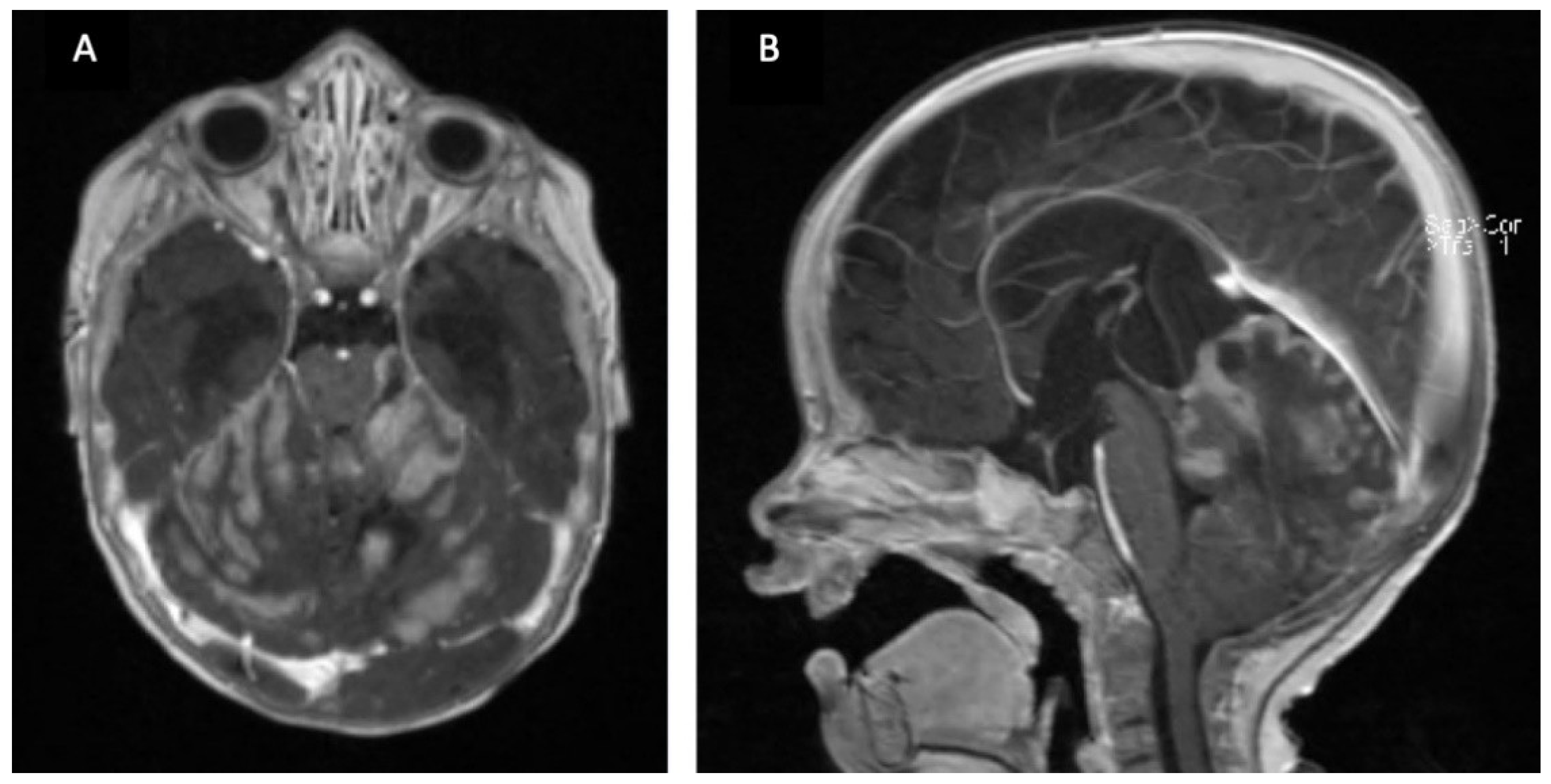
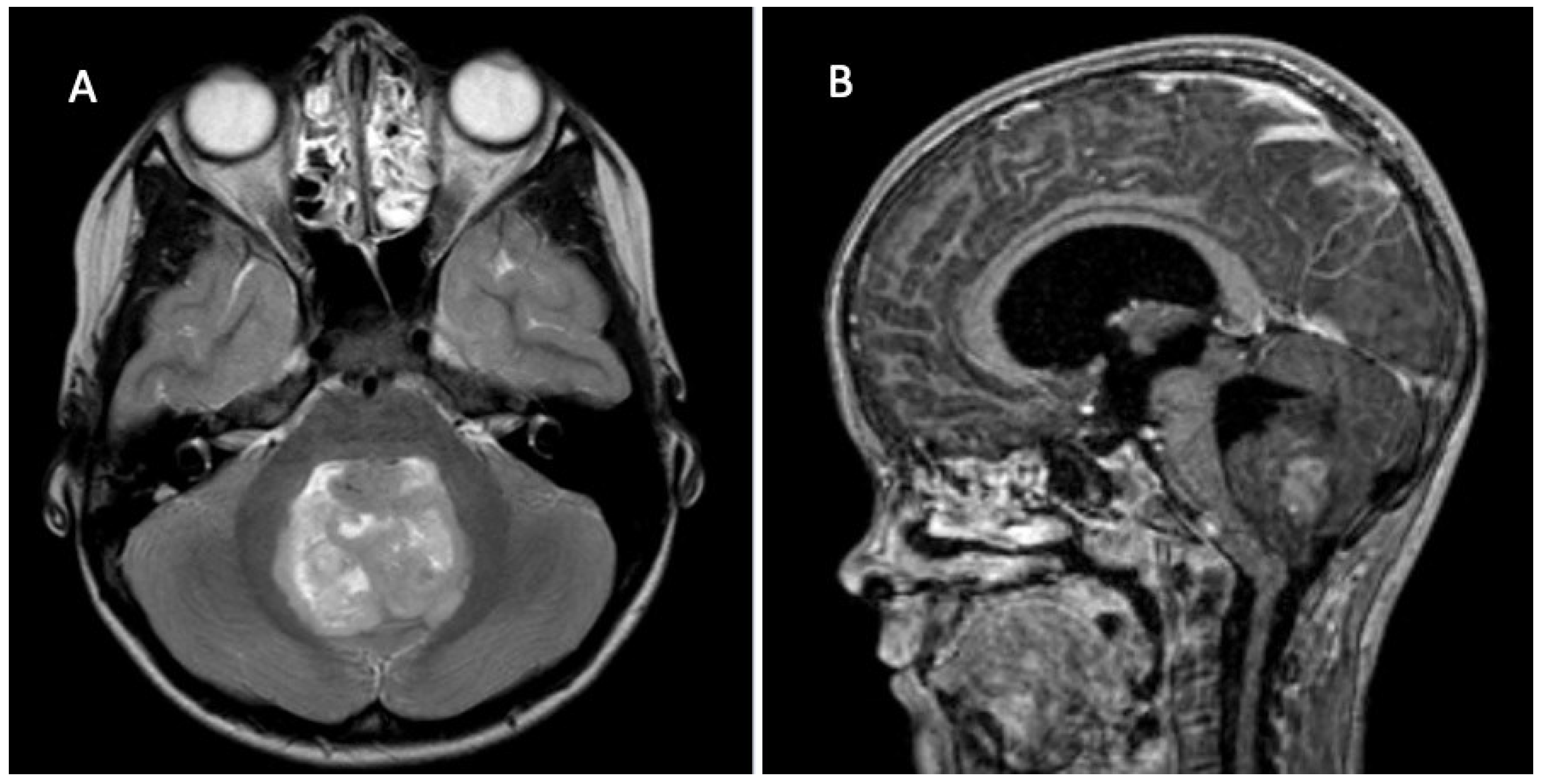
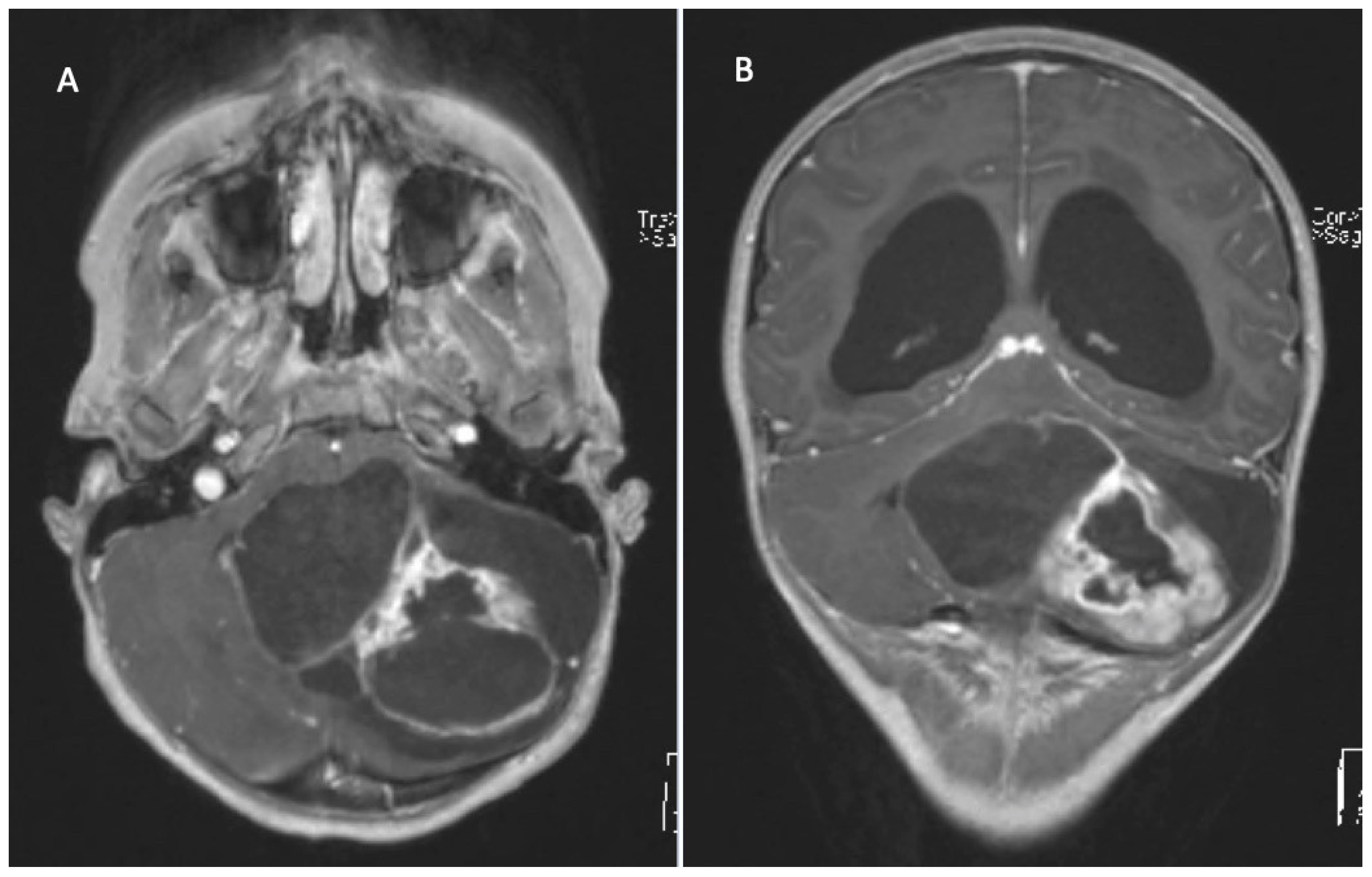
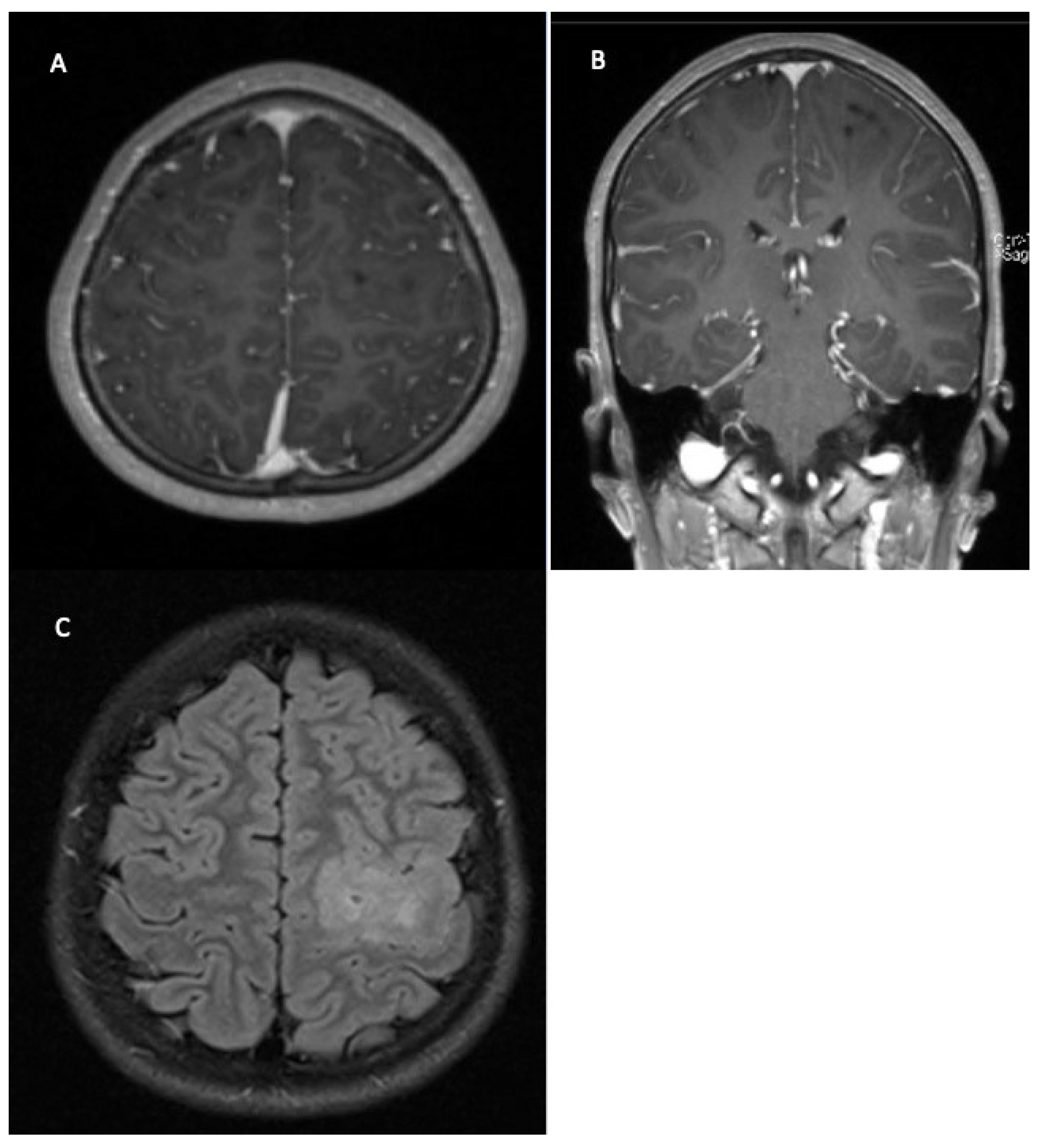
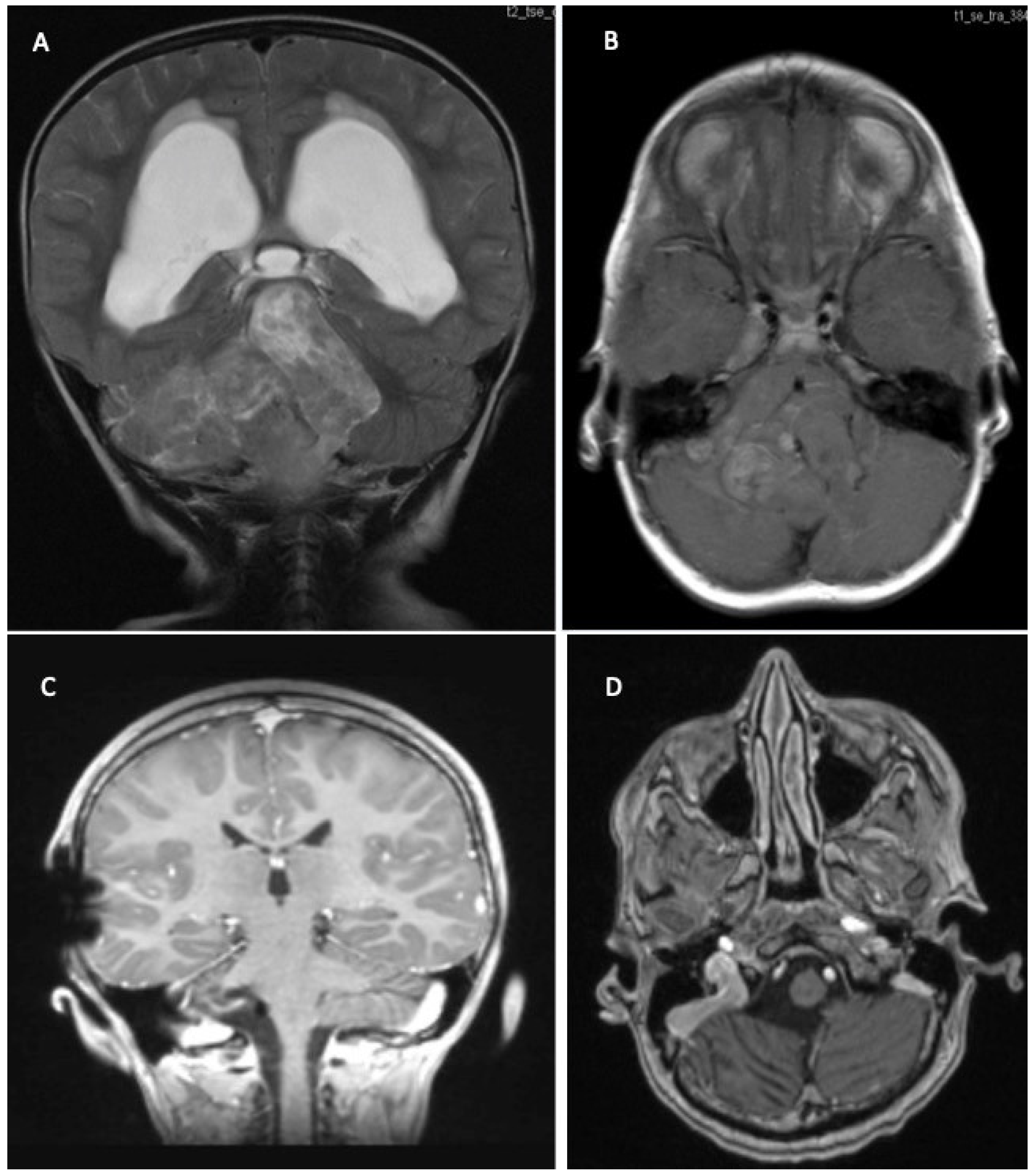
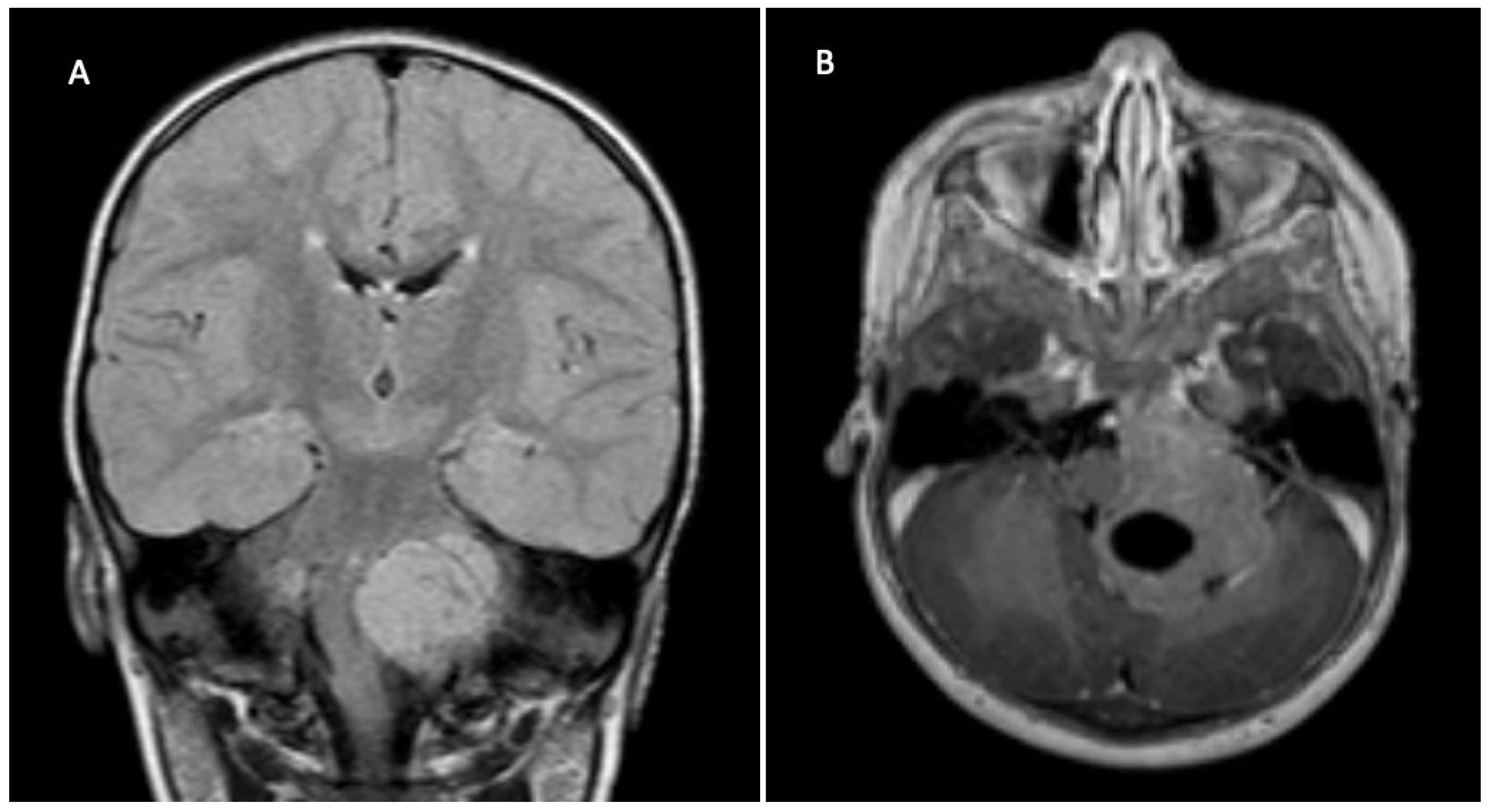
| Tumor Type | Subtype | Histopathological Classification | Molecular Information, Key Diagnostic Genes, Molecules Pathways | CNS WHO Grade 1–4 |
|---|---|---|---|---|
| Gliomas | ||||
| Pediatric-type diffuse low grade gliomas | Diffuse astrocytoma, MYB- or MYBL1-altered | Diffuse glioma with low proliferation | MYB, MYBL1 | 1–2 |
| Angiocentric glioma | astrocytic or oligodendroglial morphology | MYB | ||
| Polymorphous low-grade neuroepithelial tumor of the young | BRAF, FGFR family | |||
| Diffuse low grade glioma, MAPK pathway altered | FGFR1, BRAF | |||
| Pediatric-type diffuse high grade gliomas | Diffuse midline glioma, H3 K27-altered | glial morphology | H3 K27, TP53, ACVR1, PDGFRA, EGFR, EZHIP | 3–4 |
| Diffuse hemispheric glioma, H3 G34-mutant | H3 G34, TP53, ATRX | |||
| Diffuse pediatric-type high-grade glioma, H3-wildtype and IDH-wildtype | IDH-wildtype, H3-wildtype, PDGFRA, MYCN, EGFR, (methylome) | |||
| Infant-type hemispheric glioma | NTRK family, ALK, ROS, MET | |||
| Circumscribed astrocytic gliomas | Pilocytic astrocytoma | astrocytoma | KIAA 1549-BRAF, BRAF, NF1 | 1–3 |
| High grade astrocytoma with piloid features | BRAF, NF1, ATRX, CDKN2A/B (methylome) | |||
| Pleomorphic xanthoastrocytoma | BRAF, CDKN2A/B | |||
| Subependymal giant cell astrocytoma | TSC1, TSC2 | |||
| Chordoid glioma | PRKCA | |||
| Astroblastoma, MN1-altered | MN1 | |||
| Ependymomas | ||||
| Supratentorial ependymoma | Supratentorial ependymoma, ZFTA fusion-positive | ependymoma | ZFTA, RELA, YAP1, MAML2 | 2–3 |
| Supratentorial ependymoma, YAP1 fusion-positive | ||||
| Posterior fossa ependymoma | Posterior fossa ependymoma, group PFA | H3, K27me3, EZHIP (methylome) | ||
| Posterior fossa ependymoma, group PFB | ||||
| Spinal ependymoma | Spinal ependymoma, MYCN-amplified | NF2, MYCN | 2–3 | |
| Myxopapillary ependymoma | Myxopapillary ependymoma | 2 | ||
| Subependymoma | Subependymoma | subependymoma | 1 | |
| Embryonal brain tumors | ||||
| Medulloblastoma | Medulloblastoma, molecularly defined | medulloblastoma | 4 | |
| Medulloblastoma, wingless (WNT)-activated | CTNNB1, APC | |||
| Medulloblastoma, sonic hedghog (SHH)-activated and TP53-wildtyp | TP53, PTCH1, SUFU, SMO, MYCN, GLI2 | |||
| Medulloblastoma, SHH-activated and TP53-mutant | ||||
| Medulloblastoma, non-WNT/non-SHH: group 3 and group 4 | MYC, MYCN, PRDM6, KDM6A | |||
| Other CNS embryonal tumors | Atypical teratoid/rhabdoid tumor (ATRT) | embryonal morphology | SMARCB1, SMARCA4 | 4 |
| Cribriform neuroepithelial tumor | ||||
| Embryonal tumor with multilayered rosettes (ETMR) | C19MC, DICER1 | 4 | ||
| CNS neuroblastoma, FOXR2-activated | FOXR2 | |||
| CNS tumor with BCOR internal tandem duplication | BCOR | |||
| CNS embryonal tumor | ||||
| Tumor Type | Subtype | Surgery/Watch and Wait | Radiotherapy | Chemotherapy | Others (See also Section 4) |
|---|---|---|---|---|---|
| Gliomas | |||||
| Pediatric-type diffuse low grade gliomas (see also Section 5.3) | Diffuse astrocytoma, MYB- or MYBL1-altered [50] | + GTR / watch and wait | + when not resectable | + when not resectable and to delay radiotherapy | (+) BRAF, MEK 1/2 inhibitors and others |
| Angiocentric glioma | |||||
| Polymorphous low-grade neuroepithelial tumor of the young | |||||
| Diffuse low grade glioma, MAPK pathway altered | |||||
| Pediatric-type diffuse high grade gliomas (see also Section 5.3) | Diffuse midline glioma, H3 K27-altered [51] | + Biopsy if possible and in ethically approved clinical study [52] | + Radiotherapy | + (e.g., Temolozomide with CCNU) (+) trials-based chemotherapy (when possible to improve resectability) [52] | (+) BRAF, MEK, MAPK inhibitors, mTOR Inhibitors, histone deactylase inhibitors (for K27M mutations), and others |
| Diffuse hemispheric glioma, H3 G34-mutant [53] | + GTR, STR, Biopsy [53,54] | + Radiotherapy | (+) chemotherapy [53,54] role unclear | ||
| Diffuse pediatric-type high-grade glioma, H3-wildtype and IDH-wildtype | |||||
| Infant-type hemispheric glioma [54] | (+) TRK Inhibitor [54] | ||||
| Circumscribed astrocytic gliomas (see also Section 5.3) | Pilocytic astrocytoma | + GTR | − only when not resectable and older than 3-5 years of age | ||
| High grade astrocytoma with piloid features [55] | + GTR/STR/Biopsy [55] | (+) | + Chemotherapy (e.g., temozolomid) [55] | ||
| Pleomorphic xanthoastrocytoma [56] | + GTR | (+) unclear only when not resectable and older than 3-5 years of age | (+) unclear, might have a benefit when not resectable [56] | (+) unclear BRAF, MEK inhibitors [56] | |
| Subependymal giant cell astrocytoma [57,58] | (+) GTR more and more replaced by mTOR [57,58] | - | - | + mTOR inhibitor (for reducing tumor growth) [57,58] | |
| Ependymomas (see also Section 5.4) | |||||
| Supratentorial ependymoma | Supratentorial ependymoma, ZFTA fusion-positive Supratentorial ependymoma, YAP1 fusion-positive | + GTR + second look/repeated surgery when residual [26] | + Local radiotherapy (when older than 12-18 months of age) [26] + Craniospinal irradiation in case of CSF or spinal dissemination boost [26] | debatable, option when younger than 12-18 months of age [26] | |
| Posterior fossa ependymoma | Posterior fossa ependymoma, group PFA Posterior fossa ependymoma, group PFB | PFB or YAP fusion possibly without radiotherapy | |||
| Spinal ependymoma | Spinal ependymoma, MYCN-amplified | + GTR [26] | + Only in incomplete resection or WHO 3 [26] | - | |
| Myxopapillary ependymoma | Myxopapillary ependymoma | + GTR [26] | evaluation in incomplete resection [26] | ||
| Embryonal brain tumors | |||||
| Medulloblastoma (see also Section 5.2) | Medulloblastoma wingless (WNT)-activated | + GTR | + Craniospinal + boost to the tumor bed | + multiagent chemotherapy, Depending on subclassification (+/− intrathecal methotrexate, reduced therapy may not be required in WNT tumors) | (+) different targets: SHH: e.g., SMO-inhibitors |
| Medulloblastoma sonic hedghog (SHH)-activated and TP53-wildtyp | |||||
| Medulloblastoma SHH-activated and TP53-mutant | |||||
| Medulloblastoma non-WNT/non-SHH: group 3 and group 4 | |||||
| Other CNS embryonal tumors | Atypical teratoid/rhabdoid tumor (ATRT) [59] | + GTR | + Radiotherapy [59] | (+) unclear: multiagent and high dose chemotherapy [59] | (+) AURK, CDK4/6 and other Inhibitors [59] |
| Embryonal tumor with multilayered rosettes (ETMR) [60] | + GTR [60] | + focal or craniospinal Radiotherapy [60] | (+) chemotherapy [60] | ||
Publisher’s Note: MDPI stays neutral with regard to jurisdictional claims in published maps and institutional affiliations. |
© 2022 by the authors. Licensee MDPI, Basel, Switzerland. This article is an open access article distributed under the terms and conditions of the Creative Commons Attribution (CC BY) license (https://creativecommons.org/licenses/by/4.0/).
Share and Cite
Lutz, K.; Jünger, S.T.; Messing-Jünger, M. Essential Management of Pediatric Brain Tumors. Children 2022, 9, 498. https://doi.org/10.3390/children9040498
Lutz K, Jünger ST, Messing-Jünger M. Essential Management of Pediatric Brain Tumors. Children. 2022; 9(4):498. https://doi.org/10.3390/children9040498
Chicago/Turabian StyleLutz, Katharina, Stephanie T. Jünger, and Martina Messing-Jünger. 2022. "Essential Management of Pediatric Brain Tumors" Children 9, no. 4: 498. https://doi.org/10.3390/children9040498
APA StyleLutz, K., Jünger, S. T., & Messing-Jünger, M. (2022). Essential Management of Pediatric Brain Tumors. Children, 9(4), 498. https://doi.org/10.3390/children9040498






